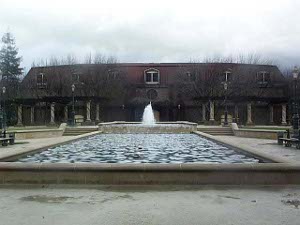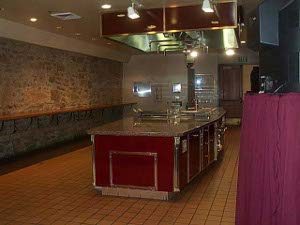 Bobcat, center of photo
things, and enjoying the opportunity of re-visiting some of our favorite places.
Bobcat, center of photo
things, and enjoying the opportunity of re-visiting some of our favorite places.
We've been showing Bob's cousin Marilyn some of the wonders of California. We have only one week, so there are many parts of the state we'll miss: the desert, the Sierra Nevada, the rice fields above Sacramento, the foggy northern coast which looks like Scotland, and so on. But we're making the most of  Bobcat, center of photo
things, and enjoying the opportunity of re-visiting some of our favorite places.
Bobcat, center of photo
things, and enjoying the opportunity of re-visiting some of our favorite places.
Leaving the San Fernando Valley, we headed north, stopping first at Fort Tejon, where, about one hundred and fifty years ago, the United States army first began to experiment with mounted troops - the dragoons. They experimented with using camels as pack animals, too, but that was less successful. Fort Tejon, near the summit of the hills at the southern end of the Central Valley of California, is a partially restored Army base, where uniformed troops reenact maneuvers once a month in summer. Now, on a sunny winter day, the only troops were civilian employees weeding the gardens.
As we walked toward the barracks we startled the first bobcat we have seen in all our years in California; he was hunting gophers in the open fields surrounding the fort and couldn't be bothered with mere humans, so we had a good look. The fort is also home to the Lebec oak, near a spot where Pierre Lebec  Francis Ford Coppola winery
was killed by a big bear, about the same time as the army was here, about 1860. Somebody wanted to memorialize the event so they carved a message on a tree: Peter Lebeck was killed by a bear. In the next fifty or so years, the tree bark grew around the message, which wasn't discovered until some of the bark was removed, along about 1900, and the lettering became visible from the inside, in reverse.
Francis Ford Coppola winery
was killed by a big bear, about the same time as the army was here, about 1860. Somebody wanted to memorialize the event so they carved a message on a tree: Peter Lebeck was killed by a bear. In the next fifty or so years, the tree bark grew around the message, which wasn't discovered until some of the bark was removed, along about 1900, and the lettering became visible from the inside, in reverse.
The rest of that day's drive was a long straight shot up the fertile Central Valley of California, past orchards and vineyards and cattle ranches and hayfields, to our destination in the San Francisco Bay area, where we joined forces with our older son Bryan and his family.
Our next big adventure was a day in the Napa Valley wine country. We drove over hills thick with deer, then visited a varied selection of attractions, starting with the Francis Ford Coppola winery (formerly Inglenook). The chateau is filled with photos and artifacts of his life as a filmmaker, and the buildings themselves are most impressive and old.
By midday we had reached the Culinary Institute of America, housed in another impressive, newly restored chateau. After observing, with some  Teaching kitchen, Culinary Institute
amusement, a classroom full of rapt spectators watching two chefs prepare pan seared halibut, we considered lunch, which is served at the Institute. If you go there, we highly recommend reservations and a fat wallet. We also recommend highly the little Mexican restaurant in the next town where we found unpretentious but delicious enchiladas, chile rellenos, and menudo.
Teaching kitchen, Culinary Institute
amusement, a classroom full of rapt spectators watching two chefs prepare pan seared halibut, we considered lunch, which is served at the Institute. If you go there, we highly recommend reservations and a fat wallet. We also recommend highly the little Mexican restaurant in the next town where we found unpretentious but delicious enchiladas, chile rellenos, and menudo.
The afternoon found us at three more wineries: Clos Pegase, where the modern artworks are as interesting as the wines; Cuvaison, a small winery with patient, chatty and friendly staff pouring a variety of white and red wine; and Mondavi, of course.
The drive, designed by Bryan, was a delight, keeping us mostly on back roads, winding up through morning rain and mist through rain forests of eucalyptus and ferns, past the extensive and elegantly groomed vineyards in Napa County, and then back along the Silverado Trail past yet more wineries, where the familiar and unfamiliar names alternate among the vines, and deer stare from their meadows not far from our car.
It was California showing one of its best faces to us.